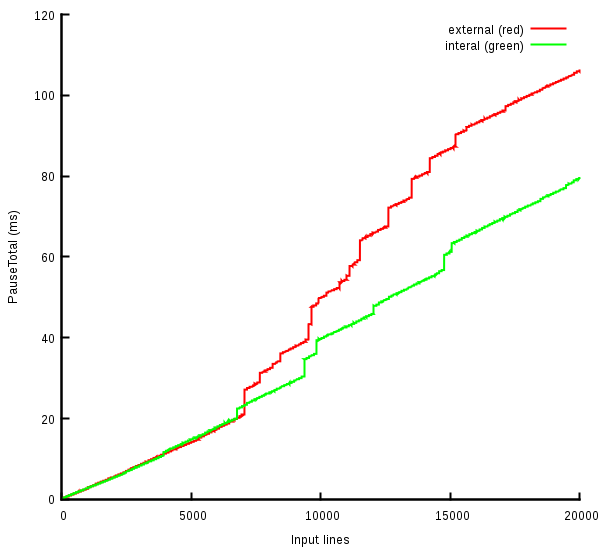Improving 'container/list'
Golang ships with a linked list1 data structure:
container/list.
The implementation is great and simple but it suffers an interesting problem: adding a value to a list requires a memory allocation.
Let me explain.
Broadly speaking a linked list can be implemented in one of two ways:
-
The list can hold a reference to the item. Let's call that an "external" implementation. The item ("Alice von Wonderland" in our example) doesn't have any knowledge of the list.
-
Or the item can hold all data required for list bookkeeping. Let's call this an "internal" implementation, as the list specific data is embedded within the item.
Subtle difference
Golang uses the first "external" method. It naturally expresses encapsulation as the item doesn't need to have any knowledge of the container.
Traversing a list feels natural, it just requires casting an abstract interface to a specific item type, for example:
type Item struct { ... } a := &Item{} list.PushFront(a) for el := list.Front(); el != nil; el = el.Next(){ item := el.Value.(ItemType) // a simple cast ... }
But, as you can see on the diagram above, that method requires allocating an additional "list element" object for every item present in the list.
The second "internal" method avoids that but compromises on encapsulation: all fields required for list bookkeeping need to be stored as a part of the item.
Traversing such a list a bit more complex - given a pointer to
"element", which is a field on the item structure, it's not trivial to
recover a pointer to the item. Linux Kernel uses a container_of
macro for that, you can often see code like this:
struct itemtype { struct list_head in_list; ... } struct list_head *element; list_for_each(element, &list) { struct itemtype *item = \ container_of(element, struct itemtype, in_list); ... }
Greg Kroah-Hartman wrote
an explanation of the container_of macro.
The unsafe hack
It is possible to achieve a similar thing in Golang. The unsafe
module can be used to emulate the container_of
trick. Here's a rough example:
type Item struct { el linkedListElement ... } a := &Item{value: "Alice"} el := &a.el recoveredA := (*Item)(unsafe.Pointer( uintptr(unsafe.Pointer(el)) - unsafe.Offsetof(tmpItem.el)))
Adapting container/list
This is a pretty complex and an error prone technique. It's simpler to
avoid using the unsafe package and adapt the standard
container/list code.
Normally the container/list always allocates a fresh "element"
object when an item is added to a list. This is fairly easy to fix,
it's enough to add a method that can recycle an "element"
object. These three lines do the trick:
func (l *list) PushElementFront(e *element) *element { return l.insert(e, &l.root) }
Having that method you can embed a list.Element structure in the
item, and use code like this to traverse a list:
type Item struct { element list.Element ... } a := &Item{} a.element.Value = a list.PushElementFront(&a.element) for el := list.Front(); el != nil; el = el.Next(){ item := el.Value.(Item) ... }
Although it's a bit wasteful, as every item holds a full
list.Element structure, this method is fairly simple and doesn't
require the additional memory allocation.
To avoid using the unsafe module item.element.Value needs to point
to item itself, which is a bit weird:
Measuring the problem
The additional memory allocation as done by default container/list is
not a big problem if the list doesn't have many entries. It starts to
be painful if your program is storing a high number of elements in a
linked list, for example if you have a large LRU cache used in your
program.
Keep in mind that in a garbage collected language allocating more objects can increase the cost of a GC run.
Let me back this claim with some evidence. I wrote two implementations of an LRU cache in Go:
- "external" is using off-the-shelf
container/listpackage - "internal" using modified implementation on the list package, as shown above
I executed the code like this:
$ go build . $ sort /usr/share/dict/*-english | ./containerlist
Here you can see the value of
runtime.HeapObjects
metric on Y axis and the runs of the program main loop as the X
axis. Drop in the value of HeapObjects indicates a GC cycle. As
expected "internal" code allocates less objects.

Next metric is the runtime.NumGC. It shows the count of garbage
colection cycles. Over long time the "external" code will trigger
lower number of garbage collection runs.

The next chart below shows the runtime.PauseTotalNs metric, a
cumulative duration of all GC runs. Although "external" code triggers
lower number of GC cycles, it still spends more time in the GC
cumulatively than the "internal" code.

Wrap up
In a garbage collected language it's important keep the allocated objects count as low as possible. It's a pity Golang doesn't support the "internal" linked lists by default. We've shown how this can be worked around and how to measure the gains.
-
What programming languages don't ship with an implementation of a linked list? ↩